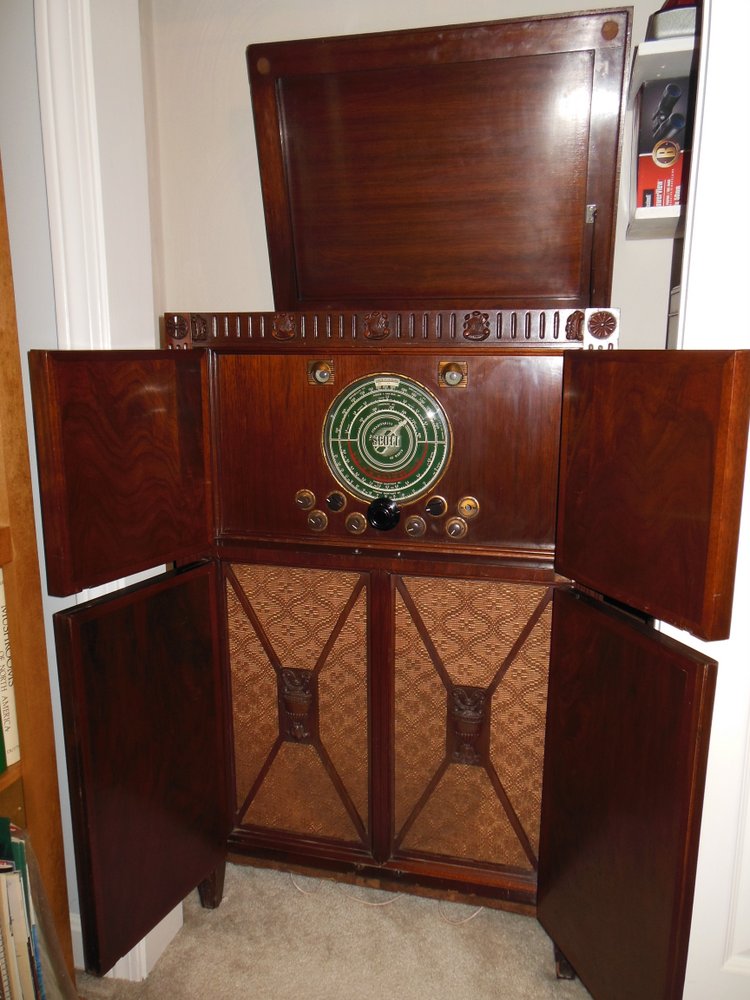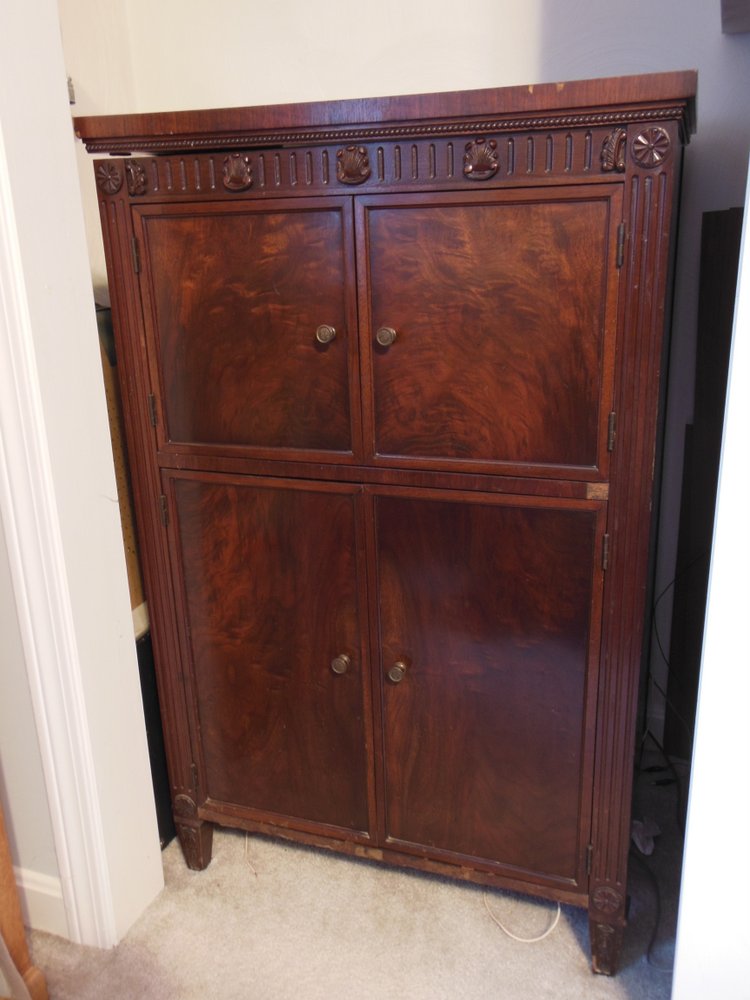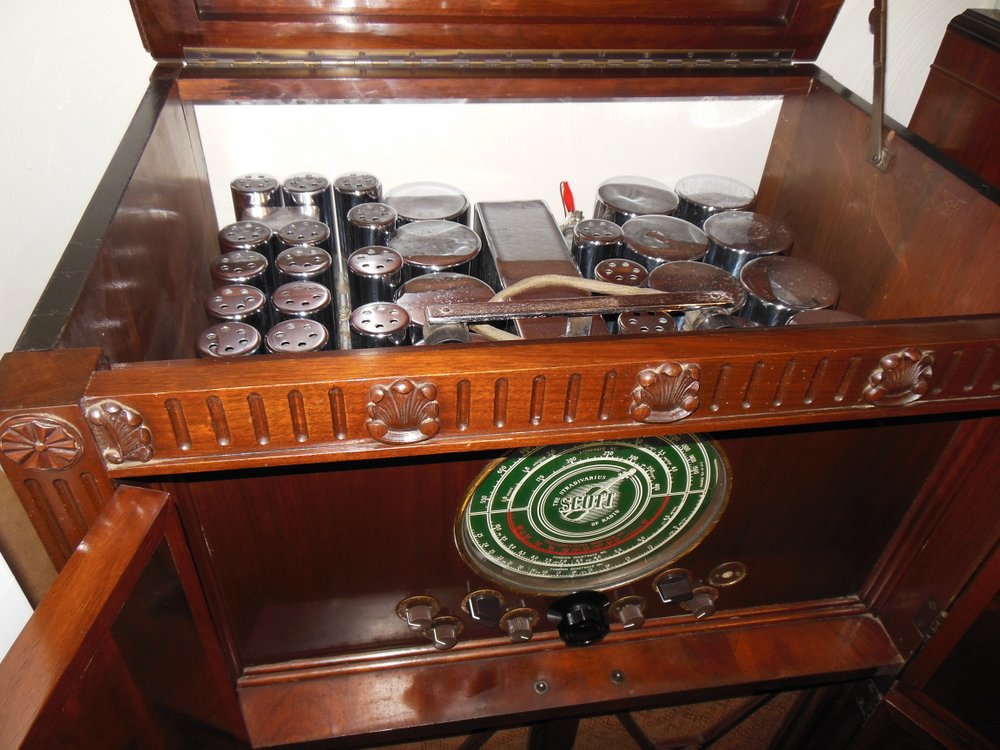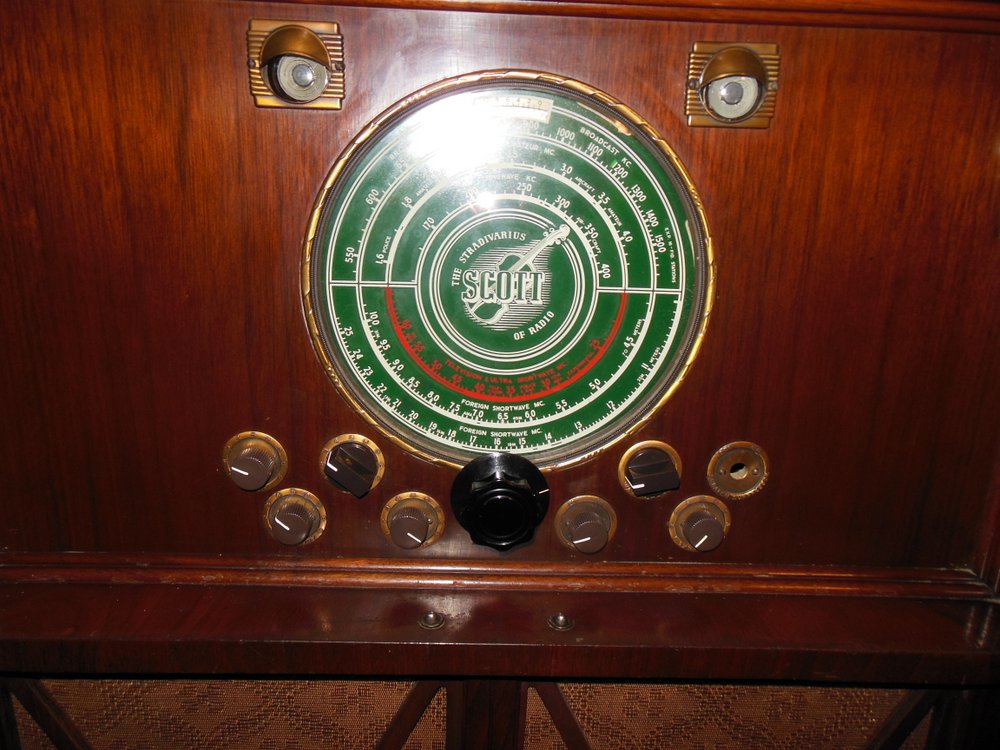In response to an inquiry in our post about the Crosley WLW Model Super-Power Radio Receiver, SWLing Post contributor, Ken Carr, writes:
I’m not sure if my radio is a ‘benchmark’ but it sure is close to it.
It is the E. H. Scott Philharmonic Beam of Light console radio.
Mine appears to have been built in 1939 or early 1940. It has 30 tubes, most of which are covered by chrome-plated shields. The power supply/amplifier (4 6L6’s in the output stage), receiver, 15″ speaker and cabinet easily weigh over 150 pounds.
It took me two years of occasional work (I am retired so I don’t rush) to get it going and working reasonably well. I had to replace over 100 capacitors and correct some B+ voltage problems left by a previous repair person.
None of the knobs are correct (mine came without them … 9 required) and replacements are difficult to come by (and quite expensive when they do appear).
When receiving a strong station the volume is such that it would easily drown out anything within 100 yards (and with no distortion).
Some day I will post some details and photos on my WordPress site (idlenot.com). I’ll be sure to let you know, Thomas. [Note: Yes, Ken, please do!]
Oh, the first time I powered it up and received a station they were playing Light My Fire (The Doors, I think). Appropriate. I put a video of it on YouTube. The radio is all apart as I was still working on it at the time.
Click here to view on YouTube.
Now that is serendipity, Ken–I mean, the first music you hear after restoring this beauty is Light My Fire? Brilliant!
The E. H. Scott Philharmonic Beam of Light is a benchmark console by any standard. I first learned about this radio through a local classified ad–the owner was selling the internal components (and original knobs) but had no cabinet. I believe he was asking $1200. The chrome plating is such eye candy, I can see why some owner in the past removed it from the cabinet to save space. Still, it was a shame the cabinet had been discarded–as one can see from your photos, the craftsmanship is simply stunning.
Ken, thank you for taking the time to share the Beam of Light console with us!
Post readers: you should check out Ken’s blog, Idlenot.com, where you’ll find more vintage radio and classic cars!





I know this is an old thread now but thought I’d comment anyway.
First that is a beautiful Philharmonic. I don’t have one but have seen a couple on other collections.
They were the Rolls Royce of radios. As far as the cabinet goes many were purchased without. some people left the chassis open because of he beautiful chrome work. Others were installed in custom cabinets. So the Scott cabinets were basically options.
As far as electrodynamic speakers go the format is not a limitation on sound. There is at least one high end Mfg. out there making some very expensive speakers using electrodynamic drivers. The system can actually be fine tuned by varying the power to the field coils changing the magnetic field strength. And trust me these are full range speakers!
In those days power supplies were expensive and hard to make in real high powers as can be done today.
Also you are correct about the field winding being used for hum canceling. It is actually used as a filter choke in the supply. It is purposely hooked up 180 deg out of phase to any hum that would get into the amplifier. Again those days large value high voltage electrolytic capacitors were expensive and difficult to make. Also tube rectifiers can only handle so much capacitance across them to keep the peak current the rectifier sees within design limits So this was an inexpensive way to more effectively filter the power supply.
I hope taht your Scott is still playing well and that you’ve found the correct knobs now!
Thanks for the nice comments.
I believe the speaker is electrodynamic although no external choke is evident on the speaker. It has separate chokes on the chassis including a special bass choke. I do have the bass and treble working although the bass cutoff is a bit sudden rather than gradual.
The tuning eye on the left tracks signal strength and the one on the right tracks the dynamic range; it follows the highs and lows of broadcast music and is adjusted by a separate ‘Expander’ control.
The radio needs to be properly aligned. Some day I may attempt it. It is a bit beyond my present limited abilities.
The radio was a gift from a friend. It once belonged to his wife’s father but had recently spent many years in the garage. They wanted it to have a good home. It has found one.
I have my grandmother’s Crosley. It has an electrodynamic speaker (4 wires vs 2). It has good volume, but it lacks in bass. It is more conventional design and I replaced several electrolytic caps. I put a jack for an external speaker and it (external) has good bass, so I think speaker issues if it was a fundamental design issue with the electrodynamic speaker. I switched around the speaker wires and it had louder hum. I believe there is some hum cancelling issues there.
What a beautiful piece of radio history and congrats on a great restore. I’m jealous!
The people involved that built this model must have been very proud of their achievements. The craftsmanship and the passion that is on the bench is something that is sadly missing today in most electronic devices. The 30-40’s period was pure wow factor for cabinet making , dial glass artwork.
Ken, thanks for the video of an astonishing console radio. The chromed cans, cabinet, twin tuning eyes, wow! I’ll bet it sounds great with the Beam of Light set on 9420 kHz for the Voice of Greece (ERT).
It looks like an electrodynamic speaker (no permanent magnet) with the magnet coil as a filter choke in the power supply? Is it weak on bass? or can it shake the floor if you turn it up. But I’ll have to admit it is a wonderful piece of furniture. I wish They made SDR radios like that (wide screen spectrum analyzer etc.) behind the doors.
The bass is great on this radio. Recently I have attached a bluetooth receiver-transmitter to it. That allows me to send hours long YouTube music through the speaker. Awesome!